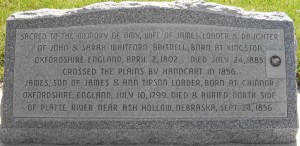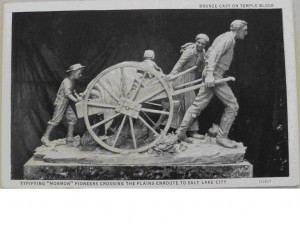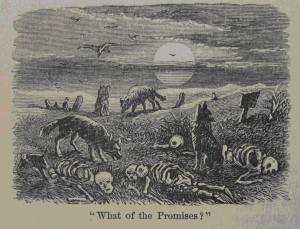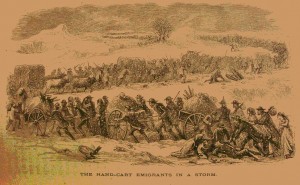I recently spent a week in Salt Lake City on vacation. One of the sites I visited was the FamilySearch library at Temple Square, run by the Jesus Christ Church of Latter-Day Saints. I’ve found most of my family history with the genealogical resources at the AAS, but I thought it would be fun to see if maybe there was something else I could find. I know, it was kind of dorky, but my husband found the ship records for his great great-grandfather from Scotland, so I wasn’t the only one into it. With the information I had on my great great-grandfather (Frank Loader Heritage) on my father’s side, I decided to see if I could go further back than him. His family had been from Aston Rowant, England, and in tracing the UK census back, I found his mother (Eliza Loader Heritage) and then her parents, my fourth great grandparents Amy Britnell and James Loader. 
Upon learning this, I now started looking up their names online and made some great discoveries. In the late 1840s or early 1850s, most of the Loader family converted to the LDS Church, through the numerous missionaries sent by Brigham Young to build up his city of Zion in Utah. In 1855, James, Amy, and nine of their thirteen children (my third great-grandmother Eliza refused to convert to the Church of LDS and stayed in England, breaking ties to her parents and siblings) emigrated to the United States and were part of the disastrous 1856 Willie and Martin handcart company tragedies. Approximately 200 of the 1000 or so emigrants died on the 1300 mile trek across the plains from Iowa City to Salt Lake City. At least two of the Loader children and their families wisely stayed in Iowa and did not make the trek in 1856.

The Martin Company left Iowa in September 1856, a few days after the Willie Company headed west. All of the Loaders, except James Loader, who died near Ash Hollow, Nebraska in September 1856, arrived in Salt Lake City in November 1856. Amy lived until 1885 in Pleasant Grove, Utah, living lastly with her daughter Patience Loader Rozsa Archer, whose journal of the trek is the best known account of the Martin Company.
So, when I returned home, I thought, I need to know about this trek, preferably from sources in that time period. After all, it is considered the most disastrous trip of the westward migration in American history. The Society has a reasonable amount of Mormon literature and histories, and of course, anti-Mormon and anti-polygamy literature from the 1840s until the 1880s. I also found a fair number of items relating to the trans-Atlantic and cross-country trip made by thousands of European converts.
In chapter 37 of Rocky Mountain Saints, Thomas Stenhouse recalls the great hand cart plan through the narrative of John Chislett, a member of the Willie Company who emigrated from England. He says of Brigham Young’s hand-cart scheme:
Whether Brigham was influenced in his desire to get the poor of Europe more rapidly to Utah by his sympathy with their condition, by his well-known love of power, his glory in numbers, or his love of wealth, which an increased amount of subservient labour would enable him to acquire, is best known to himself. But the sad results of his Hand Cart scheme will call for a day of reckoning in the future which he cannot evade.

Another account in that chapter, from an unnamed man who rode behind the Martin company, recalled what he saw on the trail and even years later:
The track of the emigrants was marked by graves, and many of the living suffered almost worse than death. One sick man there, who was holding by the wagon bars to save himself from the jolting, had all of his fingers frozen off. Men may be seen to-day in Salt Lake City, who were boys then, hobbling around on their club-feet, all their toes having been frozen off in that fearful march.

In October 1856, Brigham Young was informed of the deplorable conditions on the trail and decided to send help to the emigrants. Men were sent with food along the trail finding the Willie Company first, then the Martin Company. Even with the reinforcements, most of those who died on the trail died in the weeks after the rescue. Finally, after almost three months of walking across the plains, the Willie and Martin Saints arrived in Salt Lake City. Those who had families in the area were sent to live with them. Others, including my Loader family members, were divided amongst willing townspeople to be nursed back to health. Most of the Saints lived long lives in and around Salt Lake City, never regretting their decision to make the pilgrimage to the land of Zion.

Hi Christine – found your article by complete chance recently! I’m really interested to discover how you are descended from Frank Loader Heritage who was my grandfather and my father, John, was Frank’s youngest son of Frank’s four children from his second family (with Amy Seaton). They all resided in South-East London where I still live. My husband and I visited Salt Lake City last Oct. and also went to see Drucilla Smith at her house in Pleasant Grove! Please email soon! Best wishes, Kay Pickett
Dear Christine,
I see you post Loader as your Great grandfather’s name with Heritage as his last name. Is he a direct mail descendant of James Loader? I am a direct descendent and have seen posts of Frank Loader, some with Heritage. In my records I do not see him as a direct male descendent.
Thank you, Karol Meginness
Hi Christine
Thanks for your posting. I’m a descendent of John Loader, son of Amy and James Loader. This is such a fun family line, so many touching stories and photos. I visited with Drusilla and scanned in a lot of her stuff- if your interested.
Brook Walker